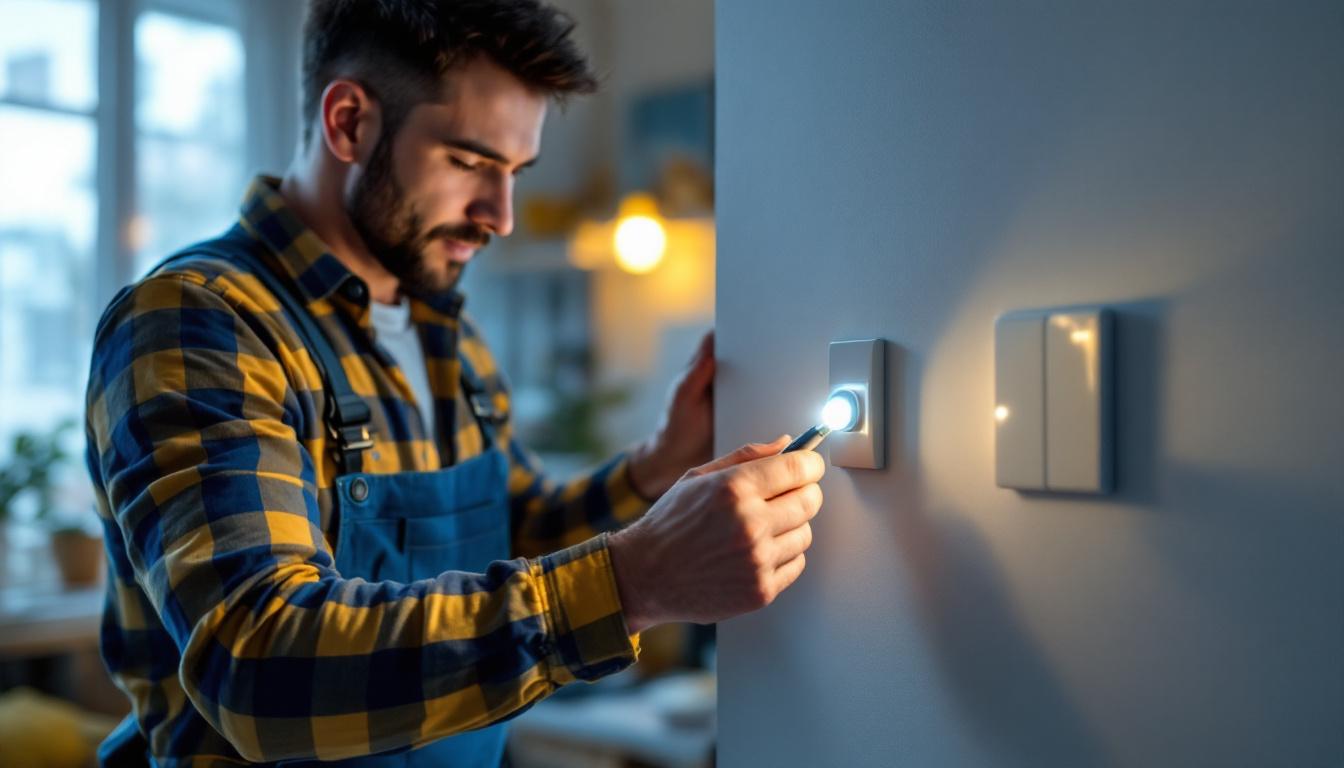
As lighting contractors, understanding the intricacies of illuminated 3-way switches is essential for delivering quality service and ensuring customer satisfaction. This article provides insights and practical tips for mastering the installation and troubleshooting of illuminated 3-way switches, enhancing both your skills and your clients’ experiences.
Illuminated 3-way switches serve a dual purpose: they allow for the control of lighting from two different locations while also providing a visual indication of the switch’s status. This feature is particularly beneficial in larger spaces or hallways where visibility may be compromised. The convenience of being able to control lighting from either end of a long corridor or staircase adds a layer of functionality that enhances the overall user experience.
These switches typically include a small light that illuminates when the switch is in the “off” position, making it easier for users to locate the switch in the dark. This is especially useful in homes with children or elderly residents, where navigating through dimly lit areas can pose safety risks. Understanding how these switches operate is crucial for any lighting contractor looking to offer comprehensive lighting solutions, as it allows them to recommend the best products for their clients’ needs.
To effectively work with illuminated 3-way switches, it is important to familiarize yourself with their components. A standard illuminated 3-way switch consists of three main parts: the switch mechanism, the illumination bulb, and the wiring connections. Each of these components plays a vital role in the switch’s functionality and efficiency.
The switch mechanism is responsible for the actual operation of the switch, allowing users to toggle the lights on and off. The illumination bulb, usually an LED, provides the necessary light to indicate the switch’s status. LEDs are favored for their longevity and energy efficiency, making them a smart choice for illuminated switches. Finally, the wiring connections ensure that the switch is properly integrated into the electrical system, allowing for seamless operation and minimizing the risk of electrical faults.
Wiring an illuminated 3-way switch involves connecting it to both the power source and the light fixture. The typical configuration includes two traveler wires that connect the two switches and a common wire that connects to the light fixture. Understanding this configuration is essential for ensuring that the switch functions correctly and safely.
When wiring, it is crucial to follow local electrical codes and regulations. This not only ensures safety but also guarantees that the installation is up to standard, which can prevent future issues for both the contractor and the homeowner. Additionally, proper wiring can enhance the performance of the switch, reducing the likelihood of flickering lights or malfunctioning switches, which can lead to unnecessary frustration for users.
Illuminated 3-way switches are commonly used in various settings, including residential homes, commercial buildings, and outdoor spaces. They are particularly useful in staircases, hallways, and large rooms where multiple entry points exist. In residential settings, these switches can be installed in places like bedrooms and living rooms, providing convenience and safety for family members.
In commercial applications, these switches can enhance safety by ensuring that employees can easily locate switches in dimly lit areas. They are often found in office buildings, warehouses, and retail spaces where lighting control is essential for both functionality and security. Understanding the different applications can help contractors provide tailored solutions to meet specific client needs, ensuring that the illuminated 3-way switches not only serve their primary purpose but also contribute to the overall aesthetic and safety of the environment.
Proper installation is key to ensuring that illuminated 3-way switches function effectively and safely. Here are some best practices to consider during installation.
Before beginning any installation, it is vital to plan the layout. Determine the locations of the switches and the light fixture, ensuring that they are easily accessible and meet the needs of the space. Consider factors such as the height of the switches and the type of lighting being used.
Additionally, gather all necessary tools and materials before starting the installation. This includes the switches, wiring, electrical tape, and any other tools required for the job. Being well-prepared can streamline the installation process and minimize potential setbacks.
Safety should always be a top priority when working with electrical components. Before starting the installation, ensure that the power is turned off at the circuit breaker. Use a voltage tester to confirm that there is no electrical current present.
Wearing appropriate safety gear, such as gloves and safety glasses, can also help protect against potential hazards. Following these safety protocols not only protects the contractor but also ensures the safety of the clients and their property.
Once the installation is complete, it is crucial to test the functionality of the illuminated 3-way switch. Turn the power back on and check that the switch illuminates when in the “off” position and that it successfully controls the light from both locations.
If any issues arise during testing, troubleshoot the wiring connections and ensure that all components are functioning correctly. A thorough testing process can help identify and resolve potential problems before the job is completed.
Even with proper installation, issues can occasionally arise with illuminated 3-way switches. Being equipped with troubleshooting knowledge can save time and enhance client satisfaction.
If the illuminated 3-way switch does not light up, the first step is to check the bulb. Ensure that the bulb is properly seated and functioning. If the bulb is intact, inspect the wiring connections to ensure they are secure and correctly configured.
Additionally, verify that the power supply to the switch is active. If the circuit breaker has tripped or there is an issue with the electrical supply, this could prevent the switch from illuminating.
When the switch illuminates but does not control the light fixture, the problem may lie in the wiring configuration. Double-check the connections between the switch and the light fixture, ensuring that the common wire is correctly connected.
It may also be beneficial to test the light fixture itself. If the fixture is faulty, replacing it may resolve the issue. Understanding these troubleshooting steps can help contractors quickly address client concerns and maintain a positive reputation.
Intermittent functionality can be frustrating for clients and contractors alike. If the switch works sporadically, it may indicate a loose connection or a faulty switch. Inspect all wiring connections for signs of wear or damage.
In some cases, replacing the switch may be the most effective solution. Ensuring that high-quality components are used can also reduce the likelihood of future issues.
Educating clients about the features and benefits of illuminated 3-way switches can enhance their overall experience and satisfaction. Providing clear explanations can empower clients to make informed decisions regarding their lighting needs.
Take the time to explain the benefits of illuminated 3-way switches to clients. Highlight how the illumination feature enhances safety and convenience, especially in dark or dimly lit areas. Clients will appreciate understanding the value of the products being installed in their homes or businesses.
Additionally, discuss the energy efficiency of modern illuminated switches, particularly those that use LED technology. Educating clients on energy savings can be a selling point that encourages them to opt for these switches over traditional options.
Offering maintenance tips can also enhance client satisfaction. Advise clients on how to care for their illuminated 3-way switches, including checking for loose connections and replacing bulbs as needed. Providing a simple maintenance guide can help clients feel more confident in their lighting choices.
Encouraging clients to reach out with any questions or concerns can foster a positive relationship and lead to repeat business. Building trust through education can set contractors apart in a competitive market.
The lighting industry is constantly evolving, with new technologies and trends emerging regularly. Staying informed about these changes can help contractors remain competitive and provide the best service to their clients.
Smart lighting technology is becoming increasingly popular among homeowners and businesses. Understanding how illuminated 3-way switches can integrate with smart home systems can open up new opportunities for contractors.
Educating clients about the benefits of smart lighting, such as remote control and automation, can enhance their overall experience. Contractors who embrace these trends can position themselves as industry leaders and attract a broader client base.
Participating in industry events, workshops, and training sessions can provide valuable insights into the latest trends and best practices. Networking with other professionals can also lead to new opportunities and collaborations.
Investing in professional development not only enhances individual skills but also contributes to the overall growth of the business. Staying connected with industry advancements can ensure that contractors remain relevant in a rapidly changing market.
Mastering the installation and troubleshooting of illuminated 3-way switches is essential for lighting contractors looking to provide exceptional service. By understanding the basics, following best practices, and staying informed about industry trends, contractors can enhance their skills and improve client satisfaction.
As the demand for innovative lighting solutions continues to grow, embracing new technologies and educating clients will be key to success. By implementing these tips, lighting contractors can position themselves as trusted experts in the field, ensuring a bright future for their business.
Ready to elevate your lighting projects with the highest quality illuminated 3-way switches and other spec-grade lighting products? Look no further than LumenWholesale, where we provide contractors like you with the best value in wholesale lighting. Our extensive selection not only meets but exceeds industry standards, ensuring every installation shines with reliability and performance. Say goodbye to local distributor markups and hello to hassle-free bulk buying with free shipping. Take the next step in mastering your craft and explore our collection for Wholesale Lighting at the Best Value today.

Discover expert tips and insights for lighting contractors on selecting and installing the brightest solar lights for outdoor projects.

Discover essential insights into solar lighting solutions for outdoor spaces tailored specifically for lighting contractors.

Discover essential tips and expert advice on outdoor deck string lights tailored for lighting contractors.

Discover the common pitfalls lighting contractors face with decorative LED light bulbs and learn how to avoid them.